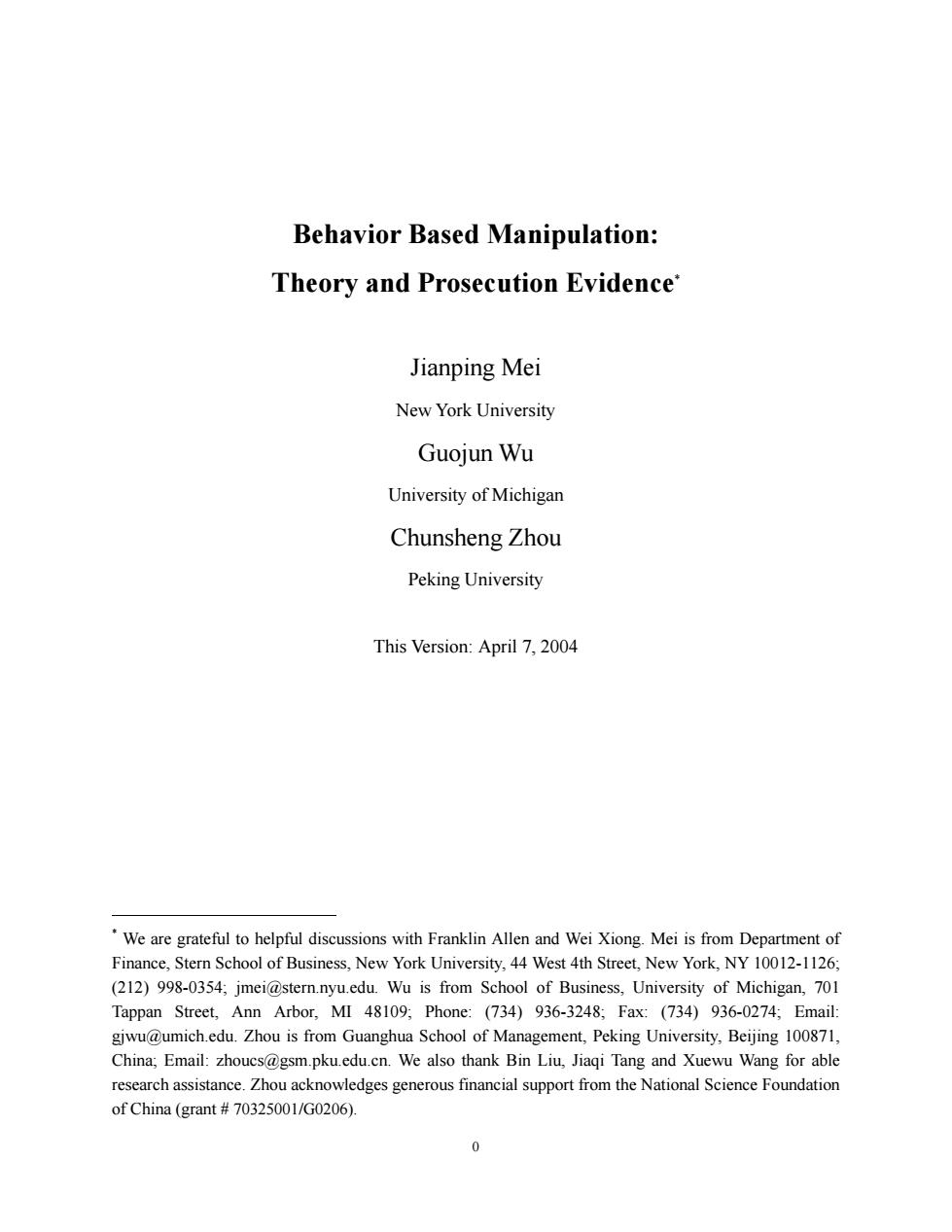
Behavior Based Manipulation: Theory and Prosecution Evidence' Jianping Mei New York University Guojun Wu University of Michigan Chunsheng Zhou Peking University This Version:April 7,2004 We are grateful to helpful discussions with Franklin Allen and Wei Xiong.Mei is from Department of Finance,Stern School of Business,New York University,44 West 4th Street,New York,NY 10012-1126; (212)998-0354;jmei@stern.nyu.edu.Wu is from School of Business,University of Michigan,701 Tappan Street,Ann Arbor,MI 48109;Phone:(734)936-3248;Fax:(734)936-0274;Email: gjwu@umich.edu.Zhou is from Guanghua School of Management,Peking University,Beijing 100871, China;Email:zhoucs@gsm.pku.edu.cn.We also thank Bin Liu,Jiagi Tang and Xuewu Wang for able research assistance.Zhou acknowledges generous financial support from the National Science Foundation of China(grant 70325001/G0206). 0
0 Behavior Based Manipulation: Theory and Prosecution Evidence* Jianping Mei New York University Guojun Wu University of Michigan Chunsheng Zhou Peking University This Version: April 7, 2004 * We are grateful to helpful discussions with Franklin Allen and Wei Xiong. Mei is from Department of Finance, Stern School of Business, New York University, 44 West 4th Street, New York, NY 10012-1126; (212) 998-0354; jmei@stern.nyu.edu. Wu is from School of Business, University of Michigan, 701 Tappan Street, Ann Arbor, MI 48109; Phone: (734) 936-3248; Fax: (734) 936-0274; Email: gjwu@umich.edu. Zhou is from Guanghua School of Management, Peking University, Beijing 100871, China; Email: zhoucs@gsm.pku.edu.cn. We also thank Bin Liu, Jiaqi Tang and Xuewu Wang for able research assistance. Zhou acknowledges generous financial support from the National Science Foundation of China (grant # 70325001/G0206)
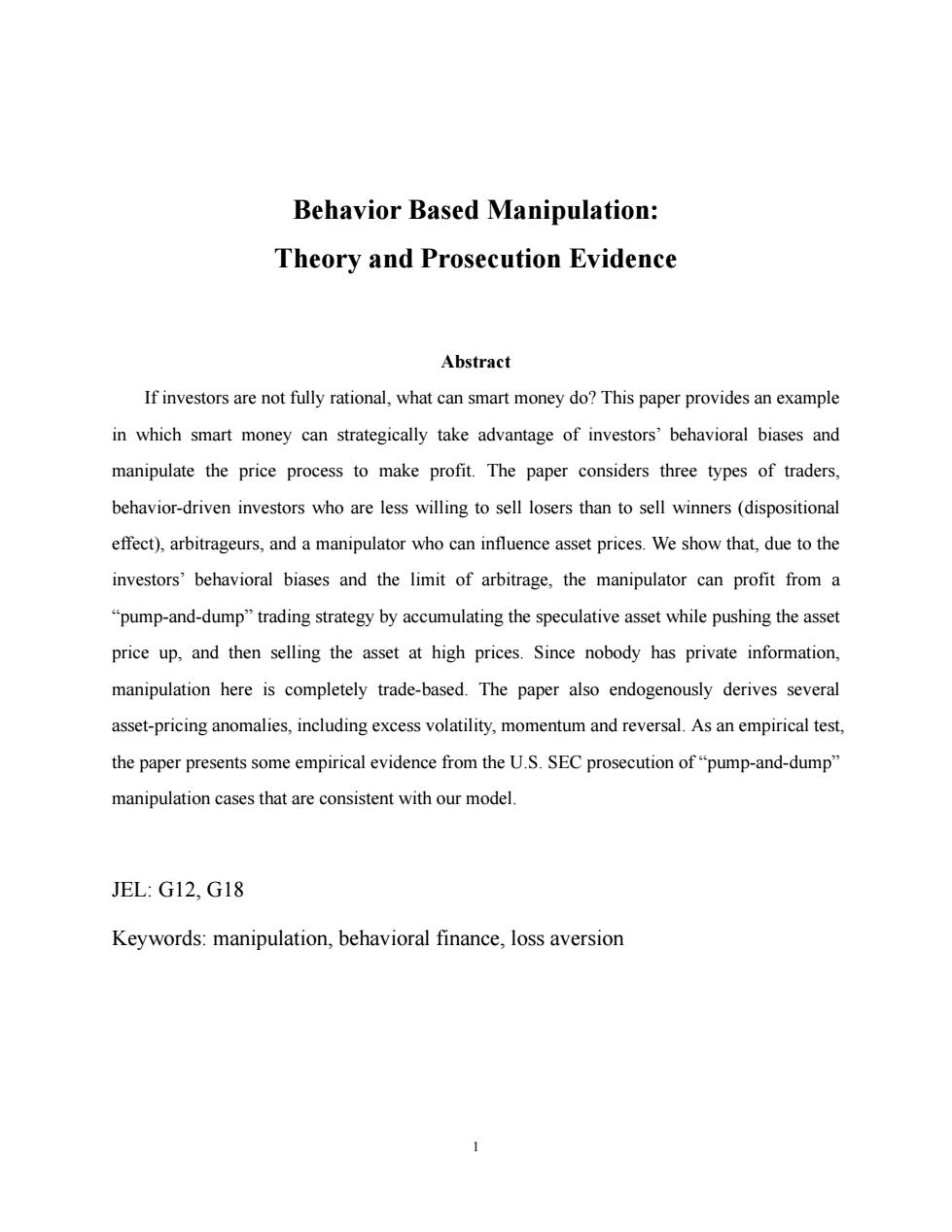
Behavior Based Manipulation: Theory and Prosecution Evidence Abstract If investors are not fully rational,what can smart money do?This paper provides an example in which smart money can strategically take advantage of investors'behavioral biases and manipulate the price process to make profit.The paper considers three types of traders, behavior-driven investors who are less willing to sell losers than to sell winners (dispositional effect),arbitrageurs,and a manipulator who can influence asset prices.We show that,due to the investors'behavioral biases and the limit of arbitrage,the manipulator can profit from a "pump-and-dump"trading strategy by accumulating the speculative asset while pushing the asset price up,and then selling the asset at high prices.Since nobody has private information, manipulation here is completely trade-based.The paper also endogenously derives several asset-pricing anomalies,including excess volatility,momentum and reversal.As an empirical test, the paper presents some empirical evidence from the U.S.SEC prosecution of"pump-and-dump" manipulation cases that are consistent with our model. JEL:G12,G18 Keywords:manipulation,behavioral finance,loss aversion
1 Behavior Based Manipulation: Theory and Prosecution Evidence Abstract If investors are not fully rational, what can smart money do? This paper provides an example in which smart money can strategically take advantage of investors’ behavioral biases and manipulate the price process to make profit. The paper considers three types of traders, behavior-driven investors who are less willing to sell losers than to sell winners (dispositional effect), arbitrageurs, and a manipulator who can influence asset prices. We show that, due to the investors’ behavioral biases and the limit of arbitrage, the manipulator can profit from a “pump-and-dump” trading strategy by accumulating the speculative asset while pushing the asset price up, and then selling the asset at high prices. Since nobody has private information, manipulation here is completely trade-based. The paper also endogenously derives several asset-pricing anomalies, including excess volatility, momentum and reversal. As an empirical test, the paper presents some empirical evidence from the U.S. SEC prosecution of “pump-and-dump” manipulation cases that are consistent with our model. JEL: G12, G18 Keywords: manipulation, behavioral finance, loss aversion
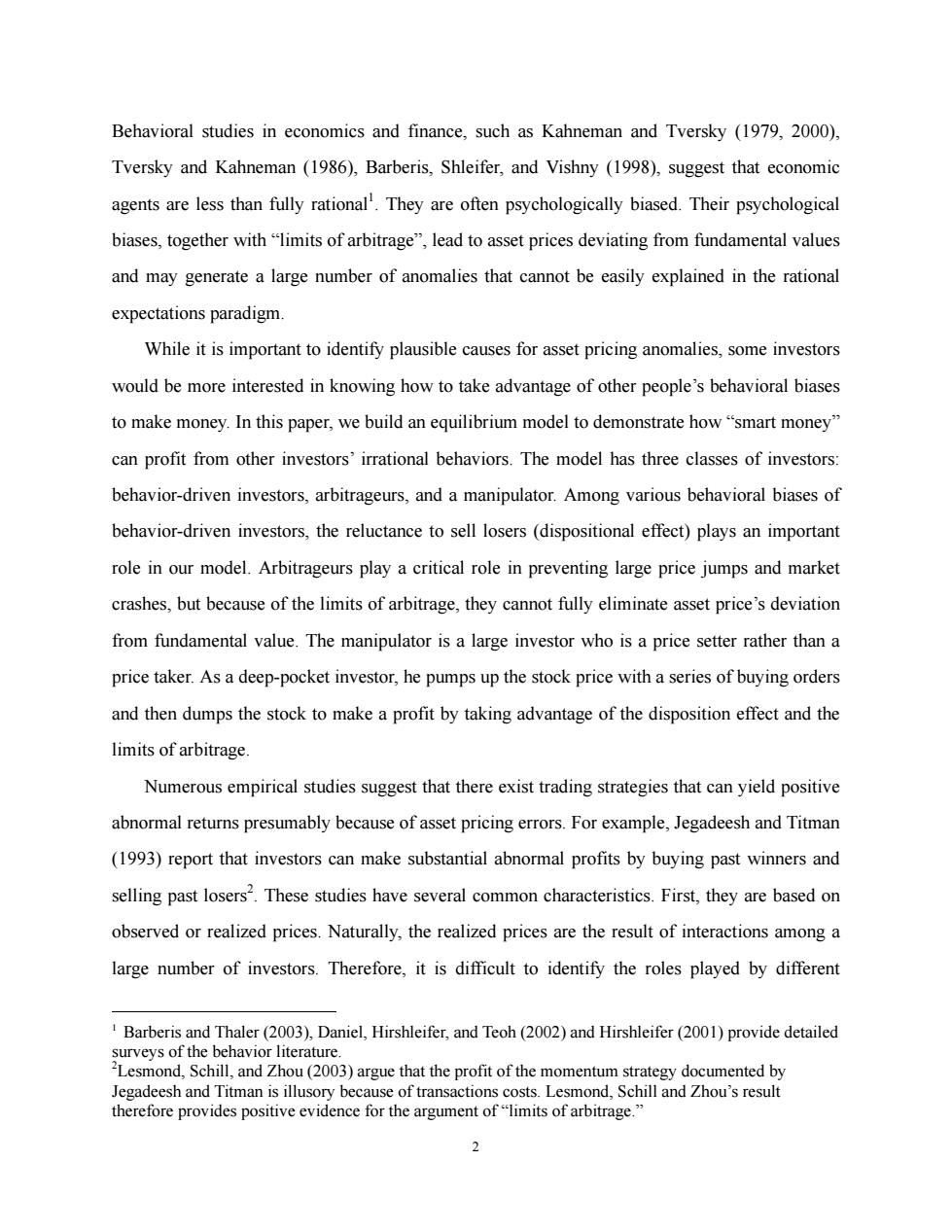
Behavioral studies in economics and finance,such as Kahneman and Tversky (1979,2000), Tversky and Kahneman (1986),Barberis,Shleifer,and Vishny (1998),suggest that economic agents are less than fully rational'.They are often psychologically biased.Their psychological biases,together with"limits of arbitrage",lead to asset prices deviating from fundamental values and may generate a large number of anomalies that cannot be easily explained in the rational expectations paradigm. While it is important to identify plausible causes for asset pricing anomalies,some investors would be more interested in knowing how to take advantage of other people's behavioral biases to make money.In this paper,we build an equilibrium model to demonstrate how "smart money" can profit from other investors'irrational behaviors.The model has three classes of investors: behavior-driven investors,arbitrageurs,and a manipulator.Among various behavioral biases of behavior-driven investors,the reluctance to sell losers (dispositional effect)plays an important role in our model.Arbitrageurs play a critical role in preventing large price jumps and market crashes,but because of the limits of arbitrage,they cannot fully eliminate asset price's deviation from fundamental value.The manipulator is a large investor who is a price setter rather than a price taker.As a deep-pocket investor,he pumps up the stock price with a series of buying orders and then dumps the stock to make a profit by taking advantage of the disposition effect and the limits of arbitrage Numerous empirical studies suggest that there exist trading strategies that can yield positive abnormal returns presumably because of asset pricing errors.For example,Jegadeesh and Titman (1993)report that investors can make substantial abnormal profits by buying past winners and selling past losers2.These studies have several common characteristics.First,they are based on observed or realized prices.Naturally,the realized prices are the result of interactions among a large number of investors.Therefore,it is difficult to identify the roles played by different Barberis and Thaler(2003),Daniel,Hirshleifer,and Teoh(2002)and Hirshleifer(2001)provide detailed surveys of the behavior literature. Lesmond,Schill,and Zhou(2003)argue that the profit of the momentum strategy documented by Jegadeesh and Titman is illusory because of transactions costs.Lesmond,Schill and Zhou's result therefore provides positive evidence for the argument of"limits of arbitrage." 2
2 Behavioral studies in economics and finance, such as Kahneman and Tversky (1979, 2000), Tversky and Kahneman (1986), Barberis, Shleifer, and Vishny (1998), suggest that economic agents are less than fully rational1 . They are often psychologically biased. Their psychological biases, together with “limits of arbitrage”, lead to asset prices deviating from fundamental values and may generate a large number of anomalies that cannot be easily explained in the rational expectations paradigm. While it is important to identify plausible causes for asset pricing anomalies, some investors would be more interested in knowing how to take advantage of other people’s behavioral biases to make money. In this paper, we build an equilibrium model to demonstrate how “smart money” can profit from other investors’ irrational behaviors. The model has three classes of investors: behavior-driven investors, arbitrageurs, and a manipulator. Among various behavioral biases of behavior-driven investors, the reluctance to sell losers (dispositional effect) plays an important role in our model. Arbitrageurs play a critical role in preventing large price jumps and market crashes, but because of the limits of arbitrage, they cannot fully eliminate asset price’s deviation from fundamental value. The manipulator is a large investor who is a price setter rather than a price taker. As a deep-pocket investor, he pumps up the stock price with a series of buying orders and then dumps the stock to make a profit by taking advantage of the disposition effect and the limits of arbitrage. Numerous empirical studies suggest that there exist trading strategies that can yield positive abnormal returns presumably because of asset pricing errors. For example, Jegadeesh and Titman (1993) report that investors can make substantial abnormal profits by buying past winners and selling past losers2 . These studies have several common characteristics. First, they are based on observed or realized prices. Naturally, the realized prices are the result of interactions among a large number of investors. Therefore, it is difficult to identify the roles played by different 1 Barberis and Thaler (2003), Daniel, Hirshleifer, and Teoh (2002) and Hirshleifer (2001) provide detailed surveys of the behavior literature. 2 Lesmond, Schill, and Zhou (2003) argue that the profit of the momentum strategy documented by Jegadeesh and Titman is illusory because of transactions costs. Lesmond, Schill and Zhou’s result therefore provides positive evidence for the argument of “limits of arbitrage
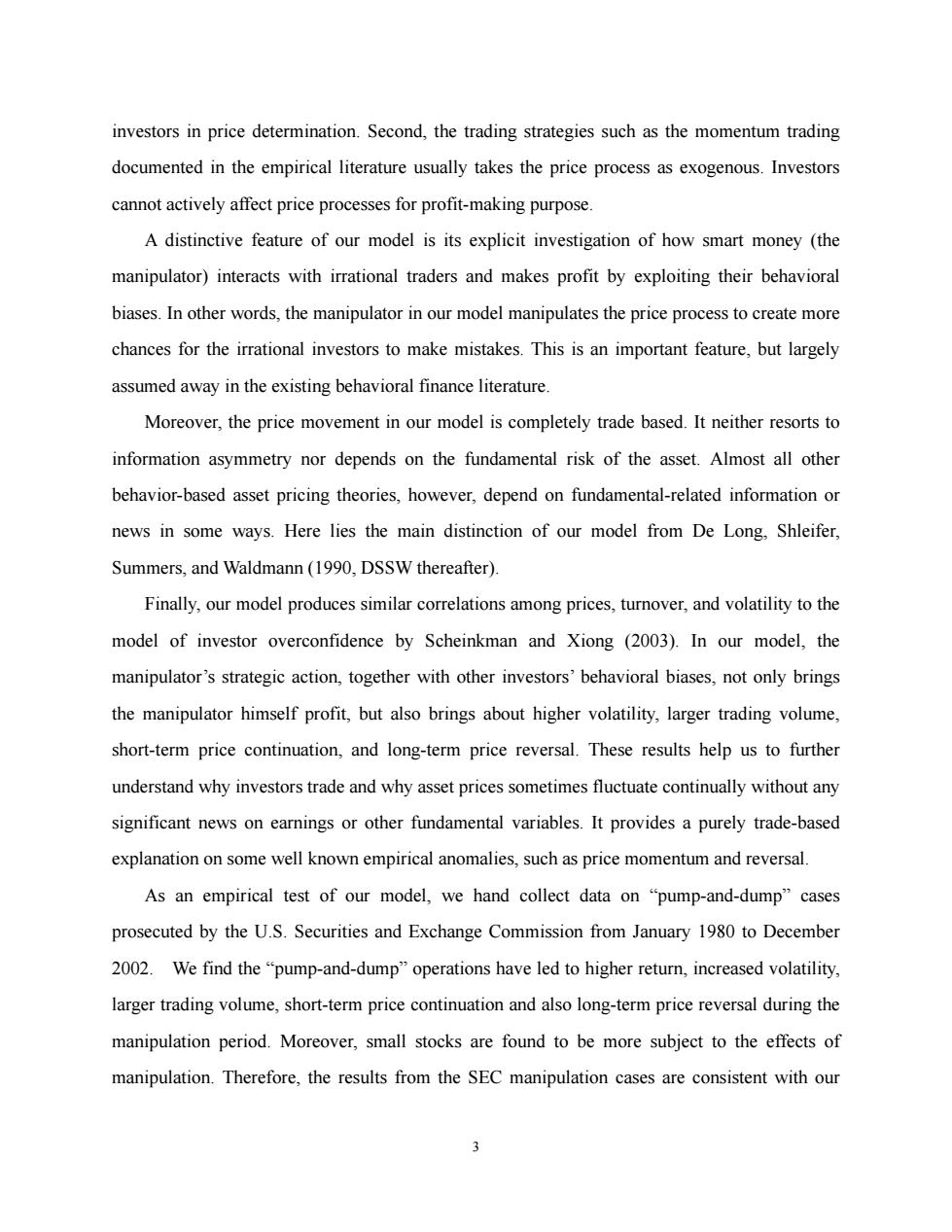
investors in price determination.Second,the trading strategies such as the momentum trading documented in the empirical literature usually takes the price process as exogenous.Investors cannot actively affect price processes for profit-making purpose. A distinctive feature of our model is its explicit investigation of how smart money (the manipulator)interacts with irrational traders and makes profit by exploiting their behavioral biases.In other words,the manipulator in our model manipulates the price process to create more chances for the irrational investors to make mistakes.This is an important feature,but largely assumed away in the existing behavioral finance literature. Moreover,the price movement in our model is completely trade based.It neither resorts to information asymmetry nor depends on the fundamental risk of the asset.Almost all other behavior-based asset pricing theories,however,depend on fundamental-related information or news in some ways.Here lies the main distinction of our model from De Long,Shleifer, Summers,and Waldmann(1990,DSSW thereafter). Finally,our model produces similar correlations among prices,turnover,and volatility to the model of investor overconfidence by Scheinkman and Xiong (2003).In our model,the manipulator's strategic action,together with other investors'behavioral biases,not only brings the manipulator himself profit,but also brings about higher volatility,larger trading volume, short-term price continuation,and long-term price reversal.These results help us to further understand why investors trade and why asset prices sometimes fluctuate continually without any significant news on earnings or other fundamental variables.It provides a purely trade-based explanation on some well known empirical anomalies,such as price momentum and reversal. As an empirical test of our model,we hand collect data on "pump-and-dump"cases prosecuted by the U.S.Securities and Exchange Commission from January 1980 to December 2002.We find the"pump-and-dump"operations have led to higher return,increased volatility, larger trading volume,short-term price continuation and also long-term price reversal during the manipulation period.Moreover,small stocks are found to be more subject to the effects of manipulation.Therefore,the results from the SEC manipulation cases are consistent with our 3
3 investors in price determination. Second, the trading strategies such as the momentum trading documented in the empirical literature usually takes the price process as exogenous. Investors cannot actively affect price processes for profit-making purpose. A distinctive feature of our model is its explicit investigation of how smart money (the manipulator) interacts with irrational traders and makes profit by exploiting their behavioral biases. In other words, the manipulator in our model manipulates the price process to create more chances for the irrational investors to make mistakes. This is an important feature, but largely assumed away in the existing behavioral finance literature. Moreover, the price movement in our model is completely trade based. It neither resorts to information asymmetry nor depends on the fundamental risk of the asset. Almost all other behavior-based asset pricing theories, however, depend on fundamental-related information or news in some ways. Here lies the main distinction of our model from De Long, Shleifer, Summers, and Waldmann (1990, DSSW thereafter). Finally, our model produces similar correlations among prices, turnover, and volatility to the model of investor overconfidence by Scheinkman and Xiong (2003). In our model, the manipulator’s strategic action, together with other investors’ behavioral biases, not only brings the manipulator himself profit, but also brings about higher volatility, larger trading volume, short-term price continuation, and long-term price reversal. These results help us to further understand why investors trade and why asset prices sometimes fluctuate continually without any significant news on earnings or other fundamental variables. It provides a purely trade-based explanation on some well known empirical anomalies, such as price momentum and reversal. As an empirical test of our model, we hand collect data on “pump-and-dump” cases prosecuted by the U.S. Securities and Exchange Commission from January 1980 to December 2002. We find the “pump-and-dump” operations have led to higher return, increased volatility, larger trading volume, short-term price continuation and also long-term price reversal during the manipulation period. Moreover, small stocks are found to be more subject to the effects of manipulation. Therefore, the results from the SEC manipulation cases are consistent with our
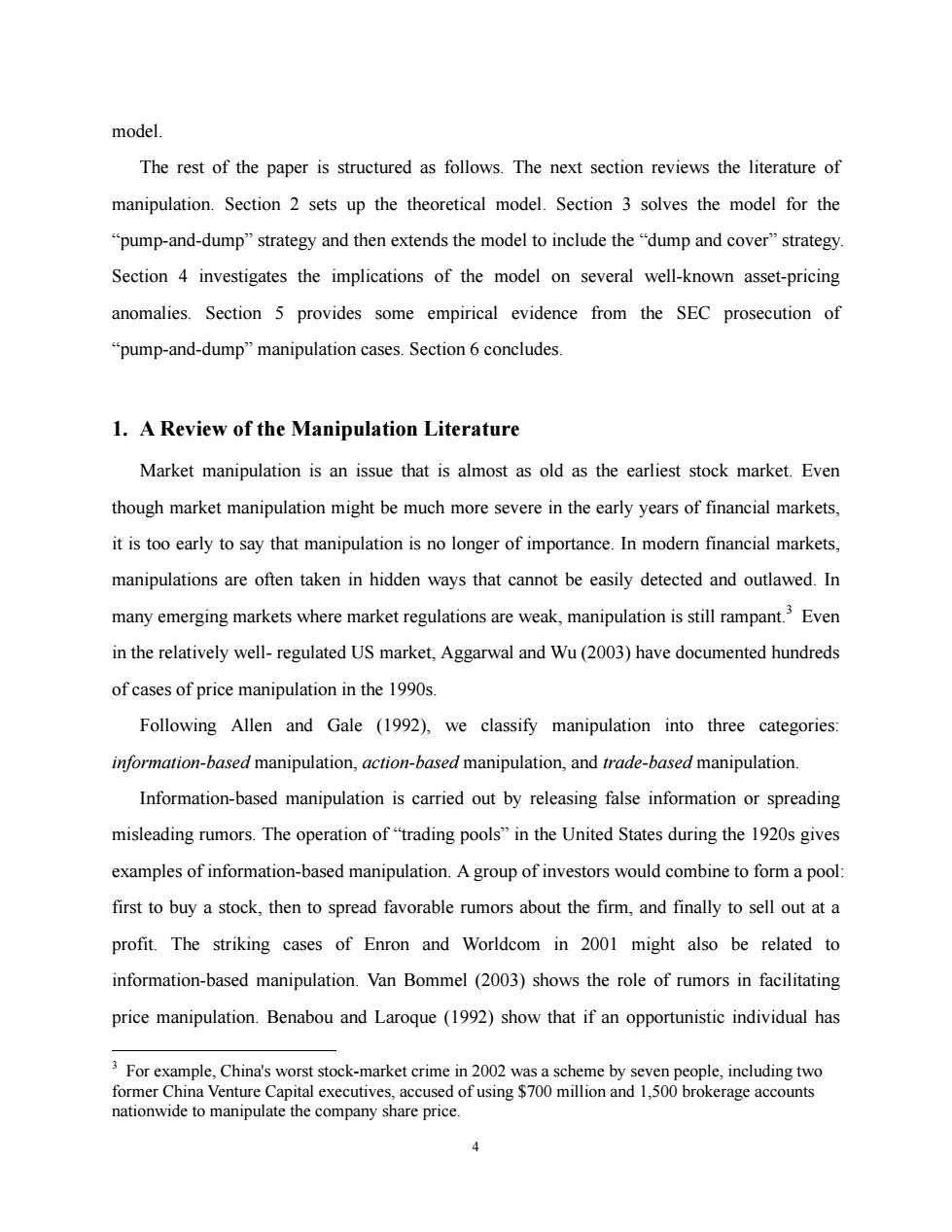
model. The rest of the paper is structured as follows.The next section reviews the literature of manipulation.Section 2 sets up the theoretical model.Section 3 solves the model for the “pump-and-dump”strategy and then extends the model to include the“dump and cover'”strategy. Section 4 investigates the implications of the model on several well-known asset-pricing anomalies.Section 5 provides some empirical evidence from the SEC prosecution of "pump-and-dump"manipulation cases.Section 6 concludes. 1.A Review of the Manipulation Literature Market manipulation is an issue that is almost as old as the earliest stock market.Even though market manipulation might be much more severe in the early years of financial markets, it is too early to say that manipulation is no longer of importance.In modern financial markets, manipulations are often taken in hidden ways that cannot be easily detected and outlawed.In many emerging markets where market regulations are weak,manipulation is still rampant.3 Even in the relatively well-regulated US market,Aggarwal and Wu(2003)have documented hundreds of cases of price manipulation in the 1990s. Following Allen and Gale (1992),we classify manipulation into three categories: information-based manipulation,action-based manipulation,and trade-based manipulation. Information-based manipulation is carried out by releasing false information or spreading misleading rumors.The operation of"trading pools"in the United States during the 1920s gives examples of information-based manipulation.A group of investors would combine to form a pool: first to buy a stock,then to spread favorable rumors about the firm,and finally to sell out at a profit.The striking cases of Enron and Worldcom in 2001 might also be related to information-based manipulation.Van Bommel (2003)shows the role of rumors in facilitating price manipulation.Benabou and Laroque (1992)show that if an opportunistic individual has 3 For example,China's worst stock-market crime in 2002 was a scheme by seven people,including two former China Venture Capital executives,accused of using $700 million and 1,500 brokerage accounts nationwide to manipulate the company share price
4 model. The rest of the paper is structured as follows. The next section reviews the literature of manipulation. Section 2 sets up the theoretical model. Section 3 solves the model for the “pump-and-dump” strategy and then extends the model to include the “dump and cover” strategy. Section 4 investigates the implications of the model on several well-known asset-pricing anomalies. Section 5 provides some empirical evidence from the SEC prosecution of “pump-and-dump” manipulation cases. Section 6 concludes. 1. A Review of the Manipulation Literature Market manipulation is an issue that is almost as old as the earliest stock market. Even though market manipulation might be much more severe in the early years of financial markets, it is too early to say that manipulation is no longer of importance. In modern financial markets, manipulations are often taken in hidden ways that cannot be easily detected and outlawed. In many emerging markets where market regulations are weak, manipulation is still rampant.3 Even in the relatively well- regulated US market, Aggarwal and Wu (2003) have documented hundreds of cases of price manipulation in the 1990s. Following Allen and Gale (1992), we classify manipulation into three categories: information-based manipulation, action-based manipulation, and trade-based manipulation. Information-based manipulation is carried out by releasing false information or spreading misleading rumors. The operation of “trading pools” in the United States during the 1920s gives examples of information-based manipulation. A group of investors would combine to form a pool: first to buy a stock, then to spread favorable rumors about the firm, and finally to sell out at a profit. The striking cases of Enron and Worldcom in 2001 might also be related to information-based manipulation. Van Bommel (2003) shows the role of rumors in facilitating price manipulation. Benabou and Laroque (1992) show that if an opportunistic individual has 3 For example, China's worst stock-market crime in 2002 was a scheme by seven people, including two former China Venture Capital executives, accused of using $700 million and 1,500 brokerage accounts nationwide to manipulate the company share price